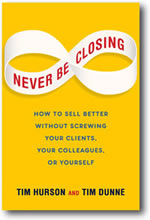 If you haven’t already noticed, I like to read quite a bit. Quite a lot, I should say. Recently, someone recommended a book co-written by Tim Hurson and Tim Dunne called, Never Be Closing: How to Sell Better Without Screwing Your Clients, Your Colleagues, or Yourself. Initially I did not care much for the title, much less the sub-heading, as I suspect the number of people motivated by “screwing their clients” is hardly anything to write home about. So, while I started the book with a lot of skepticism, to my surprise, I actually ended up really liking it.
If you haven’t already noticed, I like to read quite a bit. Quite a lot, I should say. Recently, someone recommended a book co-written by Tim Hurson and Tim Dunne called, Never Be Closing: How to Sell Better Without Screwing Your Clients, Your Colleagues, or Yourself. Initially I did not care much for the title, much less the sub-heading, as I suspect the number of people motivated by “screwing their clients” is hardly anything to write home about. So, while I started the book with a lot of skepticism, to my surprise, I actually ended up really liking it.
Now, with that said, why should YOU read the book? Without giving it all away, I’ll share a small sample of what the book covers and what I found to be the most interesting and compelling aspects.
The authors present a methodology called Productive Selling which is based on a previous concept they developed called Productive Thinking. Productive Thinking “is a structured way of approaching problems and opportunities.” Productive Selling “is a set of easy-to-apply principles and tools designed to help you discover and deliver real value to prospective clients—and transform them into ongoing, productive relationships.” In other words, Productive Selling is about having a genuine interest in the person you are working with and a sincere desire to be of use to that person.
Productive Thinking
- Be aware of patterned thinking: Humans process just about every experience through their Gator brain (limbic system, home of instinctive rather than rational reactions). The last part of the brain used to evaluate things is the cognitive rational brain. When working on complex tasks our Gator brain can get in the way. As a result, some surprisingly good ideas are shot down because our Gator brain instinctively tells us, “that’s stupid,” before our neocortex has the chance to kick in.
- Separate your thinking: You use shower thinking (because the best ideas come in the shower) or creative thinking for activity that results in “aha!” moments and critical thinking to judge the merit of those moments.
- Reach for the Third Third: The first third of a brainstorming session produces ordinary, run-of-the-mill concepts. The second stretches people because they have run out of familiar ideas. The third part of the session is where truly innovative ideas come from.
- Look for unexpected connections: Ask questions and listen with an open mind and you will find new ways to look at old things.
- The Power of the Debrief: Look at your experiences, extract useful insight from them (positive and negative) and apply those lessons moving forward.
People or Process:
- It’s all about people. Business is people. Sales is people.
- The best way to “get” people is to listen to them. Intently.
- Whether it makes you money or not, the best way to sell is to help people. The first word is always people.
The Power of Scripts
This section of the book covers how to take a good script and turn it into a great one. A great script focuses on one key point, tells a story, is relevant; and always finishes with a question. The authors illustrate this with a before and after script that powerfully demonstrates the difference between good and great scripts.
Speak to Be Heard
A sales conversation has three acts:
- Earning the Right to Ask
- Exploration
- Demonstrating Usefulness
The book states: “In order to connect with your clients it helps to understand how they see the world, how they take in information and how they process it. You have to recognize what gives them energy – and what saps it.” Over several pages the book details the different ways individuals are energized by: context, results, ideas, process, action, and people. Over and over again the book talks about the importance of asking questions and, in order to get that right, you have to connect with your prospect.
Debrief the Process
There are easy to remember formulas throughout the book. I really liked the one that covers a debriefing section called: “What? So What? Now What?”
Simply put, “What?” asks what happened. “So What?” asks why something matters. (A mini-Power Thinking exercise gets at positives and objections from “What?”) “Now What?” is the go forward plan based on what happened and what about what happened that actually matters. The example used in this section demonstrates the difference between sixteen voicemails with no response vs. a substantive voicemail with a reason to call back getting immediate results.
The final chapter is a review that includes a recap of the tools covered in the book. They include:
- Establishing success criteria for a meeting using a process called DRIVE
- Q-Notes—a nifty template for note-taking before, during and after a meeting
- The POWER grid to help with Story Mapping and answering the “So What?” question
So, how about we wrap up with our own “debrief”?
- What? You’ve read this review of Never Be Closing.
- So what? You’re interested in selling better without screwing your clients, colleagues, or yourself.
- Now what? Read it for yourself. Buy the book.



